Severity: 8192
Message: Creation of dynamic property CI_URI::$config is deprecated
Filename: core/URI.php
Line Number: 101
Backtrace:
File: /home/vinoped/domains/vinopedia.rs/public_html/index.php
Line: 315
Function: require_once
Severity: 8192
Message: Creation of dynamic property CI_Router::$uri is deprecated
Filename: core/Router.php
Line Number: 127
Backtrace:
File: /home/vinoped/domains/vinopedia.rs/public_html/index.php
Line: 315
Function: require_once
Severity: 8192
Message: Creation of dynamic property Post::$benchmark is deprecated
Filename: core/Controller.php
Line Number: 75
Backtrace:
File: /home/vinoped/domains/vinopedia.rs/public_html/application/controllers/Post.php
Line: 7
Function: __construct
File: /home/vinoped/domains/vinopedia.rs/public_html/index.php
Line: 315
Function: require_once
Severity: 8192
Message: Creation of dynamic property Post::$hooks is deprecated
Filename: core/Controller.php
Line Number: 75
Backtrace:
File: /home/vinoped/domains/vinopedia.rs/public_html/application/controllers/Post.php
Line: 7
Function: __construct
File: /home/vinoped/domains/vinopedia.rs/public_html/index.php
Line: 315
Function: require_once
Severity: 8192
Message: Creation of dynamic property Post::$config is deprecated
Filename: core/Controller.php
Line Number: 75
Backtrace:
File: /home/vinoped/domains/vinopedia.rs/public_html/application/controllers/Post.php
Line: 7
Function: __construct
File: /home/vinoped/domains/vinopedia.rs/public_html/index.php
Line: 315
Function: require_once
Severity: 8192
Message: Creation of dynamic property Post::$log is deprecated
Filename: core/Controller.php
Line Number: 75
Backtrace:
File: /home/vinoped/domains/vinopedia.rs/public_html/application/controllers/Post.php
Line: 7
Function: __construct
File: /home/vinoped/domains/vinopedia.rs/public_html/index.php
Line: 315
Function: require_once
Severity: 8192
Message: Creation of dynamic property Post::$utf8 is deprecated
Filename: core/Controller.php
Line Number: 75
Backtrace:
File: /home/vinoped/domains/vinopedia.rs/public_html/application/controllers/Post.php
Line: 7
Function: __construct
File: /home/vinoped/domains/vinopedia.rs/public_html/index.php
Line: 315
Function: require_once
Severity: 8192
Message: Creation of dynamic property Post::$uri is deprecated
Filename: core/Controller.php
Line Number: 75
Backtrace:
File: /home/vinoped/domains/vinopedia.rs/public_html/application/controllers/Post.php
Line: 7
Function: __construct
File: /home/vinoped/domains/vinopedia.rs/public_html/index.php
Line: 315
Function: require_once
Severity: 8192
Message: Creation of dynamic property Post::$exceptions is deprecated
Filename: core/Controller.php
Line Number: 75
Backtrace:
File: /home/vinoped/domains/vinopedia.rs/public_html/application/controllers/Post.php
Line: 7
Function: __construct
File: /home/vinoped/domains/vinopedia.rs/public_html/index.php
Line: 315
Function: require_once
Severity: 8192
Message: Creation of dynamic property Post::$router is deprecated
Filename: core/Controller.php
Line Number: 75
Backtrace:
File: /home/vinoped/domains/vinopedia.rs/public_html/application/controllers/Post.php
Line: 7
Function: __construct
File: /home/vinoped/domains/vinopedia.rs/public_html/index.php
Line: 315
Function: require_once
Severity: 8192
Message: Creation of dynamic property Post::$output is deprecated
Filename: core/Controller.php
Line Number: 75
Backtrace:
File: /home/vinoped/domains/vinopedia.rs/public_html/application/controllers/Post.php
Line: 7
Function: __construct
File: /home/vinoped/domains/vinopedia.rs/public_html/index.php
Line: 315
Function: require_once
Severity: 8192
Message: Creation of dynamic property Post::$security is deprecated
Filename: core/Controller.php
Line Number: 75
Backtrace:
File: /home/vinoped/domains/vinopedia.rs/public_html/application/controllers/Post.php
Line: 7
Function: __construct
File: /home/vinoped/domains/vinopedia.rs/public_html/index.php
Line: 315
Function: require_once
Severity: 8192
Message: Creation of dynamic property Post::$input is deprecated
Filename: core/Controller.php
Line Number: 75
Backtrace:
File: /home/vinoped/domains/vinopedia.rs/public_html/application/controllers/Post.php
Line: 7
Function: __construct
File: /home/vinoped/domains/vinopedia.rs/public_html/index.php
Line: 315
Function: require_once
Severity: 8192
Message: Creation of dynamic property Post::$lang is deprecated
Filename: core/Controller.php
Line Number: 75
Backtrace:
File: /home/vinoped/domains/vinopedia.rs/public_html/application/controllers/Post.php
Line: 7
Function: __construct
File: /home/vinoped/domains/vinopedia.rs/public_html/index.php
Line: 315
Function: require_once
Severity: 8192
Message: Creation of dynamic property Post::$load is deprecated
Filename: core/Controller.php
Line Number: 78
Backtrace:
File: /home/vinoped/domains/vinopedia.rs/public_html/application/controllers/Post.php
Line: 7
Function: __construct
File: /home/vinoped/domains/vinopedia.rs/public_html/index.php
Line: 315
Function: require_once
Severity: 8192
Message: Creation of dynamic property Post::$db is deprecated
Filename: core/Loader.php
Line Number: 396
Backtrace:
File: /home/vinoped/domains/vinopedia.rs/public_html/application/controllers/Post.php
Line: 7
Function: __construct
File: /home/vinoped/domains/vinopedia.rs/public_html/index.php
Line: 315
Function: require_once
Severity: 8192
Message: Creation of dynamic property CI_DB_mysqli_driver::$failover is deprecated
Filename: database/DB_driver.php
Line Number: 371
Backtrace:
File: /home/vinoped/domains/vinopedia.rs/public_html/application/controllers/Post.php
Line: 7
Function: __construct
File: /home/vinoped/domains/vinopedia.rs/public_html/index.php
Line: 315
Function: require_once
Severity: 8192
Message: Return type of CI_Session_files_driver::open($save_path, $name) should either be compatible with SessionHandlerInterface::open(string $path, string $name): bool, or the #[\ReturnTypeWillChange] attribute should be used to temporarily suppress the notice
Filename: drivers/Session_files_driver.php
Line Number: 132
Backtrace:
File: /home/vinoped/domains/vinopedia.rs/public_html/application/controllers/Post.php
Line: 7
Function: __construct
File: /home/vinoped/domains/vinopedia.rs/public_html/index.php
Line: 315
Function: require_once
Severity: 8192
Message: Return type of CI_Session_files_driver::close() should either be compatible with SessionHandlerInterface::close(): bool, or the #[\ReturnTypeWillChange] attribute should be used to temporarily suppress the notice
Filename: drivers/Session_files_driver.php
Line Number: 292
Backtrace:
File: /home/vinoped/domains/vinopedia.rs/public_html/application/controllers/Post.php
Line: 7
Function: __construct
File: /home/vinoped/domains/vinopedia.rs/public_html/index.php
Line: 315
Function: require_once
Severity: 8192
Message: Return type of CI_Session_files_driver::read($session_id) should either be compatible with SessionHandlerInterface::read(string $id): string|false, or the #[\ReturnTypeWillChange] attribute should be used to temporarily suppress the notice
Filename: drivers/Session_files_driver.php
Line Number: 166
Backtrace:
File: /home/vinoped/domains/vinopedia.rs/public_html/application/controllers/Post.php
Line: 7
Function: __construct
File: /home/vinoped/domains/vinopedia.rs/public_html/index.php
Line: 315
Function: require_once
Severity: 8192
Message: Return type of CI_Session_files_driver::write($session_id, $session_data) should either be compatible with SessionHandlerInterface::write(string $id, string $data): bool, or the #[\ReturnTypeWillChange] attribute should be used to temporarily suppress the notice
Filename: drivers/Session_files_driver.php
Line Number: 235
Backtrace:
File: /home/vinoped/domains/vinopedia.rs/public_html/application/controllers/Post.php
Line: 7
Function: __construct
File: /home/vinoped/domains/vinopedia.rs/public_html/index.php
Line: 315
Function: require_once
Severity: 8192
Message: Return type of CI_Session_files_driver::destroy($session_id) should either be compatible with SessionHandlerInterface::destroy(string $id): bool, or the #[\ReturnTypeWillChange] attribute should be used to temporarily suppress the notice
Filename: drivers/Session_files_driver.php
Line Number: 315
Backtrace:
File: /home/vinoped/domains/vinopedia.rs/public_html/application/controllers/Post.php
Line: 7
Function: __construct
File: /home/vinoped/domains/vinopedia.rs/public_html/index.php
Line: 315
Function: require_once
Severity: 8192
Message: Return type of CI_Session_files_driver::gc($maxlifetime) should either be compatible with SessionHandlerInterface::gc(int $max_lifetime): int|false, or the #[\ReturnTypeWillChange] attribute should be used to temporarily suppress the notice
Filename: drivers/Session_files_driver.php
Line Number: 356
Backtrace:
File: /home/vinoped/domains/vinopedia.rs/public_html/application/controllers/Post.php
Line: 7
Function: __construct
File: /home/vinoped/domains/vinopedia.rs/public_html/index.php
Line: 315
Function: require_once
Severity: Warning
Message: ini_set(): Session ini settings cannot be changed after headers have already been sent
Filename: Session/Session.php
Line Number: 282
Backtrace:
File: /home/vinoped/domains/vinopedia.rs/public_html/application/controllers/Post.php
Line: 7
Function: __construct
File: /home/vinoped/domains/vinopedia.rs/public_html/index.php
Line: 315
Function: require_once
Severity: Warning
Message: session_set_cookie_params(): Session cookie parameters cannot be changed after headers have already been sent
Filename: Session/Session.php
Line Number: 289
Backtrace:
File: /home/vinoped/domains/vinopedia.rs/public_html/application/controllers/Post.php
Line: 7
Function: __construct
File: /home/vinoped/domains/vinopedia.rs/public_html/index.php
Line: 315
Function: require_once
Severity: Warning
Message: ini_set(): Session ini settings cannot be changed after headers have already been sent
Filename: Session/Session.php
Line Number: 304
Backtrace:
File: /home/vinoped/domains/vinopedia.rs/public_html/application/controllers/Post.php
Line: 7
Function: __construct
File: /home/vinoped/domains/vinopedia.rs/public_html/index.php
Line: 315
Function: require_once
Severity: Warning
Message: ini_set(): Session ini settings cannot be changed after headers have already been sent
Filename: Session/Session.php
Line Number: 314
Backtrace:
File: /home/vinoped/domains/vinopedia.rs/public_html/application/controllers/Post.php
Line: 7
Function: __construct
File: /home/vinoped/domains/vinopedia.rs/public_html/index.php
Line: 315
Function: require_once
Severity: Warning
Message: ini_set(): Session ini settings cannot be changed after headers have already been sent
Filename: Session/Session.php
Line Number: 315
Backtrace:
File: /home/vinoped/domains/vinopedia.rs/public_html/application/controllers/Post.php
Line: 7
Function: __construct
File: /home/vinoped/domains/vinopedia.rs/public_html/index.php
Line: 315
Function: require_once
Severity: Warning
Message: ini_set(): Session ini settings cannot be changed after headers have already been sent
Filename: Session/Session.php
Line Number: 316
Backtrace:
File: /home/vinoped/domains/vinopedia.rs/public_html/application/controllers/Post.php
Line: 7
Function: __construct
File: /home/vinoped/domains/vinopedia.rs/public_html/index.php
Line: 315
Function: require_once
Severity: Warning
Message: ini_set(): Session ini settings cannot be changed after headers have already been sent
Filename: Session/Session.php
Line Number: 317
Backtrace:
File: /home/vinoped/domains/vinopedia.rs/public_html/application/controllers/Post.php
Line: 7
Function: __construct
File: /home/vinoped/domains/vinopedia.rs/public_html/index.php
Line: 315
Function: require_once
Severity: Warning
Message: ini_set(): Session ini settings cannot be changed after headers have already been sent
Filename: Session/Session.php
Line Number: 375
Backtrace:
File: /home/vinoped/domains/vinopedia.rs/public_html/application/controllers/Post.php
Line: 7
Function: __construct
File: /home/vinoped/domains/vinopedia.rs/public_html/index.php
Line: 315
Function: require_once
Severity: Warning
Message: session_set_save_handler(): Session save handler cannot be changed after headers have already been sent
Filename: Session/Session.php
Line Number: 110
Backtrace:
File: /home/vinoped/domains/vinopedia.rs/public_html/application/controllers/Post.php
Line: 7
Function: __construct
File: /home/vinoped/domains/vinopedia.rs/public_html/index.php
Line: 315
Function: require_once
Severity: Warning
Message: session_start(): Session cannot be started after headers have already been sent
Filename: Session/Session.php
Line Number: 143
Backtrace:
File: /home/vinoped/domains/vinopedia.rs/public_html/application/controllers/Post.php
Line: 7
Function: __construct
File: /home/vinoped/domains/vinopedia.rs/public_html/index.php
Line: 315
Function: require_once
Severity: 8192
Message: Creation of dynamic property Post::$session is deprecated
Filename: core/Loader.php
Line Number: 1283
Backtrace:
File: /home/vinoped/domains/vinopedia.rs/public_html/application/controllers/Post.php
Line: 7
Function: __construct
File: /home/vinoped/domains/vinopedia.rs/public_html/index.php
Line: 315
Function: require_once
Severity: 8192
Message: Creation of dynamic property Post::$form_validation is deprecated
Filename: core/Loader.php
Line Number: 1283
Backtrace:
File: /home/vinoped/domains/vinopedia.rs/public_html/application/controllers/Post.php
Line: 7
Function: __construct
File: /home/vinoped/domains/vinopedia.rs/public_html/index.php
Line: 315
Function: require_once
Severity: 8192
Message: Creation of dynamic property Post::$page_model is deprecated
Filename: core/Loader.php
Line Number: 358
Backtrace:
File: /home/vinoped/domains/vinopedia.rs/public_html/application/controllers/Post.php
Line: 8
Function: model
File: /home/vinoped/domains/vinopedia.rs/public_html/index.php
Line: 315
Function: require_once
Severity: 8192
Message: Creation of dynamic property Post::$podesavanja_model is deprecated
Filename: core/Loader.php
Line Number: 358
Backtrace:
File: /home/vinoped/domains/vinopedia.rs/public_html/application/controllers/Post.php
Line: 9
Function: model
File: /home/vinoped/domains/vinopedia.rs/public_html/index.php
Line: 315
Function: require_once
Severity: 8192
Message: filter_var(): Passing null to parameter #3 ($options) of type array|int is deprecated
Filename: core/Input.php
Line Number: 572
Backtrace:
File: /home/vinoped/domains/vinopedia.rs/public_html/application/models/Page_model.php
Line: 426
Function: ip_address
File: /home/vinoped/domains/vinopedia.rs/public_html/application/controllers/Post.php
Line: 26
Function: visitors
File: /home/vinoped/domains/vinopedia.rs/public_html/index.php
Line: 315
Function: require_once
Severity: 8192
Message: Creation of dynamic property CI_Loader::$benchmark is deprecated
Filename: core/Loader.php
Line Number: 931
Backtrace:
File: /home/vinoped/domains/vinopedia.rs/public_html/application/controllers/Post.php
Line: 77
Function: view
File: /home/vinoped/domains/vinopedia.rs/public_html/index.php
Line: 315
Function: require_once
Severity: 8192
Message: Creation of dynamic property CI_Loader::$hooks is deprecated
Filename: core/Loader.php
Line Number: 931
Backtrace:
File: /home/vinoped/domains/vinopedia.rs/public_html/application/controllers/Post.php
Line: 77
Function: view
File: /home/vinoped/domains/vinopedia.rs/public_html/index.php
Line: 315
Function: require_once
Severity: 8192
Message: Creation of dynamic property CI_Loader::$config is deprecated
Filename: core/Loader.php
Line Number: 931
Backtrace:
File: /home/vinoped/domains/vinopedia.rs/public_html/application/controllers/Post.php
Line: 77
Function: view
File: /home/vinoped/domains/vinopedia.rs/public_html/index.php
Line: 315
Function: require_once
Severity: 8192
Message: Creation of dynamic property CI_Loader::$log is deprecated
Filename: core/Loader.php
Line Number: 931
Backtrace:
File: /home/vinoped/domains/vinopedia.rs/public_html/application/controllers/Post.php
Line: 77
Function: view
File: /home/vinoped/domains/vinopedia.rs/public_html/index.php
Line: 315
Function: require_once
Severity: 8192
Message: Creation of dynamic property CI_Loader::$utf8 is deprecated
Filename: core/Loader.php
Line Number: 931
Backtrace:
File: /home/vinoped/domains/vinopedia.rs/public_html/application/controllers/Post.php
Line: 77
Function: view
File: /home/vinoped/domains/vinopedia.rs/public_html/index.php
Line: 315
Function: require_once
Severity: 8192
Message: Creation of dynamic property CI_Loader::$uri is deprecated
Filename: core/Loader.php
Line Number: 931
Backtrace:
File: /home/vinoped/domains/vinopedia.rs/public_html/application/controllers/Post.php
Line: 77
Function: view
File: /home/vinoped/domains/vinopedia.rs/public_html/index.php
Line: 315
Function: require_once
Severity: 8192
Message: Creation of dynamic property CI_Loader::$exceptions is deprecated
Filename: core/Loader.php
Line Number: 931
Backtrace:
File: /home/vinoped/domains/vinopedia.rs/public_html/application/controllers/Post.php
Line: 77
Function: view
File: /home/vinoped/domains/vinopedia.rs/public_html/index.php
Line: 315
Function: require_once
Severity: 8192
Message: Creation of dynamic property CI_Loader::$router is deprecated
Filename: core/Loader.php
Line Number: 931
Backtrace:
File: /home/vinoped/domains/vinopedia.rs/public_html/application/controllers/Post.php
Line: 77
Function: view
File: /home/vinoped/domains/vinopedia.rs/public_html/index.php
Line: 315
Function: require_once
Severity: 8192
Message: Creation of dynamic property CI_Loader::$output is deprecated
Filename: core/Loader.php
Line Number: 931
Backtrace:
File: /home/vinoped/domains/vinopedia.rs/public_html/application/controllers/Post.php
Line: 77
Function: view
File: /home/vinoped/domains/vinopedia.rs/public_html/index.php
Line: 315
Function: require_once
Severity: 8192
Message: Creation of dynamic property CI_Loader::$security is deprecated
Filename: core/Loader.php
Line Number: 931
Backtrace:
File: /home/vinoped/domains/vinopedia.rs/public_html/application/controllers/Post.php
Line: 77
Function: view
File: /home/vinoped/domains/vinopedia.rs/public_html/index.php
Line: 315
Function: require_once
Severity: 8192
Message: Creation of dynamic property CI_Loader::$input is deprecated
Filename: core/Loader.php
Line Number: 931
Backtrace:
File: /home/vinoped/domains/vinopedia.rs/public_html/application/controllers/Post.php
Line: 77
Function: view
File: /home/vinoped/domains/vinopedia.rs/public_html/index.php
Line: 315
Function: require_once
Severity: 8192
Message: Creation of dynamic property CI_Loader::$lang is deprecated
Filename: core/Loader.php
Line Number: 931
Backtrace:
File: /home/vinoped/domains/vinopedia.rs/public_html/application/controllers/Post.php
Line: 77
Function: view
File: /home/vinoped/domains/vinopedia.rs/public_html/index.php
Line: 315
Function: require_once
Severity: 8192
Message: Creation of dynamic property CI_Loader::$load is deprecated
Filename: core/Loader.php
Line Number: 931
Backtrace:
File: /home/vinoped/domains/vinopedia.rs/public_html/application/controllers/Post.php
Line: 77
Function: view
File: /home/vinoped/domains/vinopedia.rs/public_html/index.php
Line: 315
Function: require_once
Severity: 8192
Message: Creation of dynamic property CI_Loader::$db is deprecated
Filename: core/Loader.php
Line Number: 931
Backtrace:
File: /home/vinoped/domains/vinopedia.rs/public_html/application/controllers/Post.php
Line: 77
Function: view
File: /home/vinoped/domains/vinopedia.rs/public_html/index.php
Line: 315
Function: require_once
Severity: 8192
Message: Creation of dynamic property CI_Loader::$session is deprecated
Filename: core/Loader.php
Line Number: 931
Backtrace:
File: /home/vinoped/domains/vinopedia.rs/public_html/application/controllers/Post.php
Line: 77
Function: view
File: /home/vinoped/domains/vinopedia.rs/public_html/index.php
Line: 315
Function: require_once
Severity: 8192
Message: Creation of dynamic property CI_Loader::$form_validation is deprecated
Filename: core/Loader.php
Line Number: 931
Backtrace:
File: /home/vinoped/domains/vinopedia.rs/public_html/application/controllers/Post.php
Line: 77
Function: view
File: /home/vinoped/domains/vinopedia.rs/public_html/index.php
Line: 315
Function: require_once
Severity: 8192
Message: Creation of dynamic property CI_Loader::$page_model is deprecated
Filename: core/Loader.php
Line Number: 931
Backtrace:
File: /home/vinoped/domains/vinopedia.rs/public_html/application/controllers/Post.php
Line: 77
Function: view
File: /home/vinoped/domains/vinopedia.rs/public_html/index.php
Line: 315
Function: require_once
Severity: 8192
Message: Creation of dynamic property CI_Loader::$podesavanja_model is deprecated
Filename: core/Loader.php
Line Number: 931
Backtrace:
File: /home/vinoped/domains/vinopedia.rs/public_html/application/controllers/Post.php
Line: 77
Function: view
File: /home/vinoped/domains/vinopedia.rs/public_html/index.php
Line: 315
Function: require_once
News
News / 10/04/2012 / 1966
 I woke up with growing excitement because I would pay my first visit to the wine region which was called "Serbian Champagne" in 1904 by the French consul Decot. Župa may not be fortunate enough to be positioned in the vicinity of Belgrade, so it is not frequented by wine tourists like some wine regions in Vojvodina, in north Serbia, yet owing to its being nestled in a vast valley surrounded by mountains Kopaonik, Željin and Goč, it managed to preserve centuries-old continuity in vinegrowing and wine-making until present day.
There is no heavy traffic on the highway, no more road works, so these 225 km don't seem to be strenuous. While the car is gliding gently on the highway, I observe the surrounding countryside imagining that almost entirely alongside the highway, it would be possible to plant vineyards, both on the left and right side of the highway, within boundaries of existing vinegrowing regions. And this is particularly true for hills on the left side of the highway, past Paraćin... And I must stress that I have already spotted a few new small vineyards on this hill, so I hope their numbers will multiply in the future.
There is a saying that nobody passes by Aleksandrovac, but a man needs to head for Aleksandrovac in order to get there. Well, this time, a large number of cars on the road from Kruševac to Aleksandrovac was heading for the same destination - Župa Grape Harvest. The landscape around Aleksandrovac looks almost surreal - rows of vineyards spreading down hillsides, and even from the distance, we can distinguish between old and new vineyards...
Having entered the town, we passed by gigantic concrete tanks of Vino Župa which bear witness to size and capacity of this industrial giant from the period of former Yugoslavia. Nowadays, Vino Župa was privatized with domestic capital, and beside wine, their range of products also includes fruit juice, vegetable, spirits, fruit puree and concentrate, frozen fruit and vegetable. Thus, tradition of nine cooperatives which merged in 1956 still lives.
In the town's center, colourful stands where one can buy traditional folk costumes, souvenirs, handicrafts, domestic jam and fruit preserve, pottery...
I woke up with growing excitement because I would pay my first visit to the wine region which was called "Serbian Champagne" in 1904 by the French consul Decot. Župa may not be fortunate enough to be positioned in the vicinity of Belgrade, so it is not frequented by wine tourists like some wine regions in Vojvodina, in north Serbia, yet owing to its being nestled in a vast valley surrounded by mountains Kopaonik, Željin and Goč, it managed to preserve centuries-old continuity in vinegrowing and wine-making until present day.
There is no heavy traffic on the highway, no more road works, so these 225 km don't seem to be strenuous. While the car is gliding gently on the highway, I observe the surrounding countryside imagining that almost entirely alongside the highway, it would be possible to plant vineyards, both on the left and right side of the highway, within boundaries of existing vinegrowing regions. And this is particularly true for hills on the left side of the highway, past Paraćin... And I must stress that I have already spotted a few new small vineyards on this hill, so I hope their numbers will multiply in the future.
There is a saying that nobody passes by Aleksandrovac, but a man needs to head for Aleksandrovac in order to get there. Well, this time, a large number of cars on the road from Kruševac to Aleksandrovac was heading for the same destination - Župa Grape Harvest. The landscape around Aleksandrovac looks almost surreal - rows of vineyards spreading down hillsides, and even from the distance, we can distinguish between old and new vineyards...
Having entered the town, we passed by gigantic concrete tanks of Vino Župa which bear witness to size and capacity of this industrial giant from the period of former Yugoslavia. Nowadays, Vino Župa was privatized with domestic capital, and beside wine, their range of products also includes fruit juice, vegetable, spirits, fruit puree and concentrate, frozen fruit and vegetable. Thus, tradition of nine cooperatives which merged in 1956 still lives.
In the town's center, colourful stands where one can buy traditional folk costumes, souvenirs, handicrafts, domestic jam and fruit preserve, pottery...
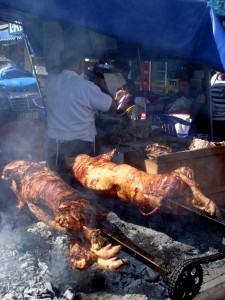



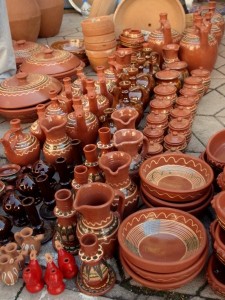
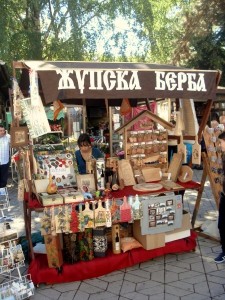 At the town's square, right next to the monument of Grape Picker, the atmosphere is particularly lively. Smoke and smells of roast meat permeate the air, which even a vegetarian couldn't remain indifferent to... While dancers and singers from local folk dance and song ensembles present on stage cultural tradition of this part of Serbia, I linger by the Wine Fountain, for which Župa Grape Harvest has become famous. During Župa Grape Harvest, wine is running in this fountain instead of water, and all visitors can drink wine from it free of charge. This year, sponsor of the Wine Fountain is companyVino Župa which provided wine for the fountain during the event.
At the town's square, right next to the monument of Grape Picker, the atmosphere is particularly lively. Smoke and smells of roast meat permeate the air, which even a vegetarian couldn't remain indifferent to... While dancers and singers from local folk dance and song ensembles present on stage cultural tradition of this part of Serbia, I linger by the Wine Fountain, for which Župa Grape Harvest has become famous. During Župa Grape Harvest, wine is running in this fountain instead of water, and all visitors can drink wine from it free of charge. This year, sponsor of the Wine Fountain is companyVino Župa which provided wine for the fountain during the event.
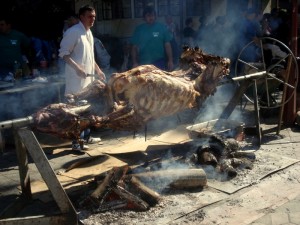


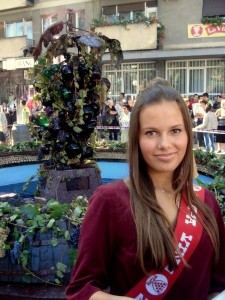
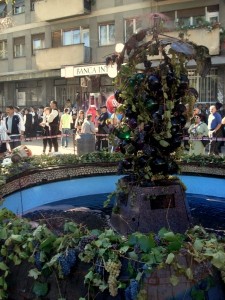
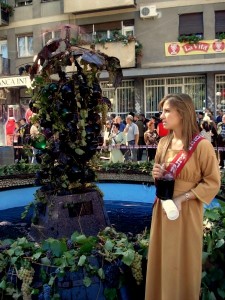 In the Wine Street, a number of small wineries from Župa offer their wines - of course, Prokupac and Tamjanika varieties prevail. I notice that well-known and well-positioned wineries on the Serbian market, such as Winery Ivanović, Budimir, Botunjac, Radenković, are not present among exhibitors... While I was touring stands in the Wine Street, I stopped by the stand of touristic/wine-making facility "Nikolić Vineyards" from the village of Vitkovo, 3 km far from Aleksandrovac. Nikolić Vineyards presented their label Vinogradi Nikolić Crveno, a blend of Cabernet Sauvignon, Merlot and Prokupac which aged in Serbian oak barrels.
In the Wine Street, a number of small wineries from Župa offer their wines - of course, Prokupac and Tamjanika varieties prevail. I notice that well-known and well-positioned wineries on the Serbian market, such as Winery Ivanović, Budimir, Botunjac, Radenković, are not present among exhibitors... While I was touring stands in the Wine Street, I stopped by the stand of touristic/wine-making facility "Nikolić Vineyards" from the village of Vitkovo, 3 km far from Aleksandrovac. Nikolić Vineyards presented their label Vinogradi Nikolić Crveno, a blend of Cabernet Sauvignon, Merlot and Prokupac which aged in Serbian oak barrels.
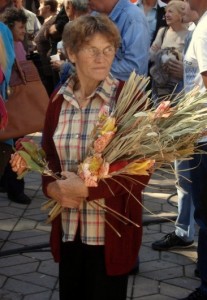

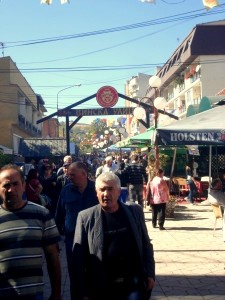






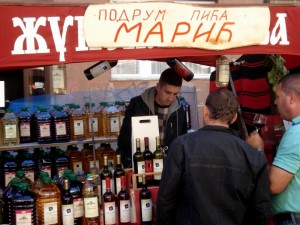

 Building of the Agricultural School "Saint Triphone" was the venue of local fruit and vegetable exhibition as well as a wine exhibition, where all important wine makers from Župa presented their wines. And here, one could find Ivanović Cellar, Minić Wine House, Radenković Wineco and many others...
Building of the Agricultural School "Saint Triphone" was the venue of local fruit and vegetable exhibition as well as a wine exhibition, where all important wine makers from Župa presented their wines. And here, one could find Ivanović Cellar, Minić Wine House, Radenković Wineco and many others...
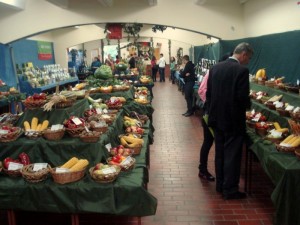

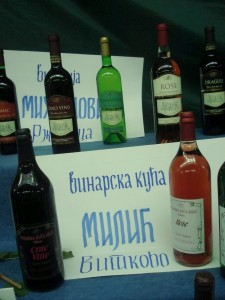
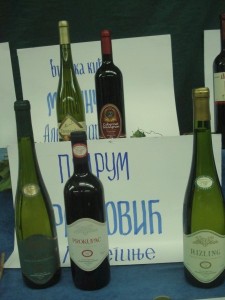
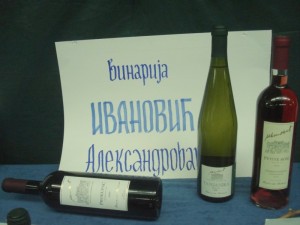
 Of course, a visit to Aleksandrovac must include a tour of the Museum of Wine-Making and Vinegrowing, which depicts a history of wine-making and vinegrowing in Župa.
Of course, a visit to Aleksandrovac must include a tour of the Museum of Wine-Making and Vinegrowing, which depicts a history of wine-making and vinegrowing in Župa.


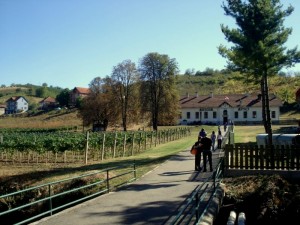
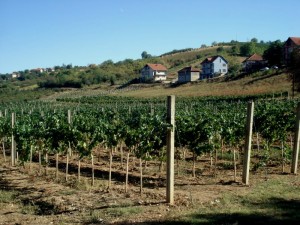
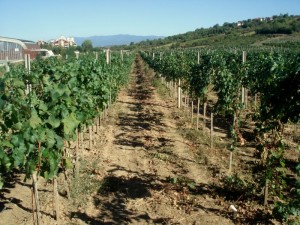
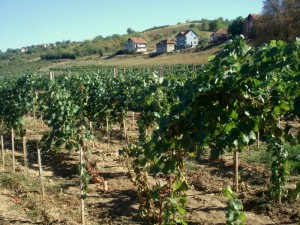 The Museum is surrounded by vineyards belonging to the Agricultural School. In front of Museum, there is an ancient hail cannon. Numerous photographs are hanging on the walls of the Museum Hall and telling an exciting story of past decades and history of wine-making in Župa.
The Museum is surrounded by vineyards belonging to the Agricultural School. In front of Museum, there is an ancient hail cannon. Numerous photographs are hanging on the walls of the Museum Hall and telling an exciting story of past decades and history of wine-making in Župa.
The most interesting part of the museum comprises Poljanski dvor i.e. interior of a typical Župa Poljana, seasonal vinegrower's dwelling place where vinegrowers used to reside during the spring and autumn works in the vineyard. Poljanas are clustered settlements with narrow alleys in the vineyards. Today, the most famous Poljanas are Lukarevina in the vicinity of Drenča monastery, Pokrep, Boćka, Ježevica, etc.
In the museum section called Fermentation Room, one can see traditional method of handling grapes, as it used to be done back in 1924, when teachers and students of Agricultural School used to bring in grapes through open windows and make wine in this room. I have to stress here that this museum's collection is the most comprehensive wine-making & vinegrowing entity in Serbia. There is another smaller collection in the Museum of Agriculture in the village of Kulpin which focuses primarily on history of wine-making and vinegrowing in Vojvodina province.
Župa is truly a unique part of our country. At every step, you come across evidence that you are in the wine-making region, and the view of vineyards on surrounding hills gives you a feeling that you are at a special place. For that reason, it is not surprising that Župa is included in touristic wine routes of Serbia. While you drive on local roads, road signs indicating local wineries will await you at every crossroads. This time, my final destination was Budimir Winery. Even before I reached the winery, good news arrived - Budimir Winery has recently shipped the first quantities of their wine to USA (New York). Aleksandar Aca Rašković, the winery owner, welcomed me in the winery. The atmosphere is quite lively in the winery - visitors come and go, both those who are well-acquainted with wines of this winery and those who followed road signs to the winery with an intention to get to know better Budimir wines.
Coming to Župa during grape harvest is indeed a special occasion, and Aleksandar contibuted to exclusivity of the day by bringing out to taste wines which will go for sale only in the period to come... Budimir Winery is not in a hurry to release new wines on the market. Instead, wines are allowed to age, mature, and then rise in full strength in front of consumers and admirers. Thus, we tasted pure Prokupac wine in all its splendour. In front of my eyes did quickly flash an image of surprised face of those wine connoisseurs who believed that Prokupac cannot give a top-class wine, therefore it should be blended with other international varieties. Therefore, remember my words and stay patient for a little while, until The King of Župa from Budimir Winery reaches shelves in shops in full glory and splendour. The other novelty is pure Merlot, which will further enrich varietal wine range of Budimir Winery. After the tasting, we went for a visit to vineyards of Budimir Winery. The winery owns 17 hectares of vineyards, and we made a tour of two locations: Gubovac and Svračak.

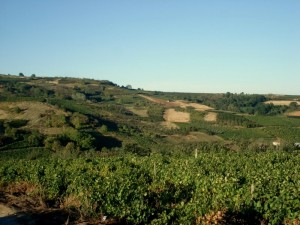
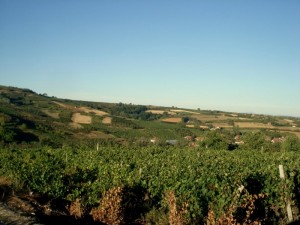
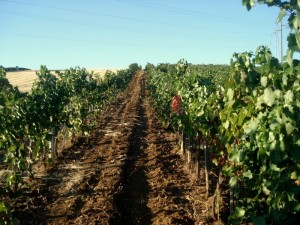
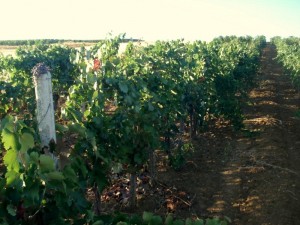
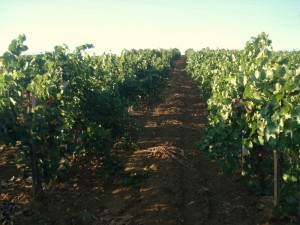
 And finally, in order to give opportunity to all our senses to enjoy during this visit to Aleksandrovac, it was logical to eat some local food in the restaurant "Ambijent" in Aleksandrovac. In the pleasant interior of the restaurant, delicacies of Župa cuisine are offered together with a selection of wines from the best local wineries. Indeed, all compliments to the owner of this restaurant who selected only local wineries in the wine list... because surely nobody comes to Župa in order to drink wines from Macedonia, Croatia or some other wine region of the world, but to taste terroir of this Serbian wine paradise.
And finally, in order to give opportunity to all our senses to enjoy during this visit to Aleksandrovac, it was logical to eat some local food in the restaurant "Ambijent" in Aleksandrovac. In the pleasant interior of the restaurant, delicacies of Župa cuisine are offered together with a selection of wines from the best local wineries. Indeed, all compliments to the owner of this restaurant who selected only local wineries in the wine list... because surely nobody comes to Župa in order to drink wines from Macedonia, Croatia or some other wine region of the world, but to taste terroir of this Serbian wine paradise.

Tomislav Ivanović
Awarded wine writer, wine critic and contributor to selected wine magazines. WSET3-certified author and editor-in-chief of www.vinopedia.rs. Member of Vojvodina Sommelier Association. Juror in national and international wine competitions. Lecturing about wines of Serbia and the Balkans. Local partner of Wine Mosaic organization. Co-founder of International Prokupac Day.

Pročitajte i druge članke iz ove rubrike:


VRANAC NA RASKRSNICI
PROČITAJ VIŠE


BALKVIWINE 2025 BEOGRAD
PROČITAJ VIŠE
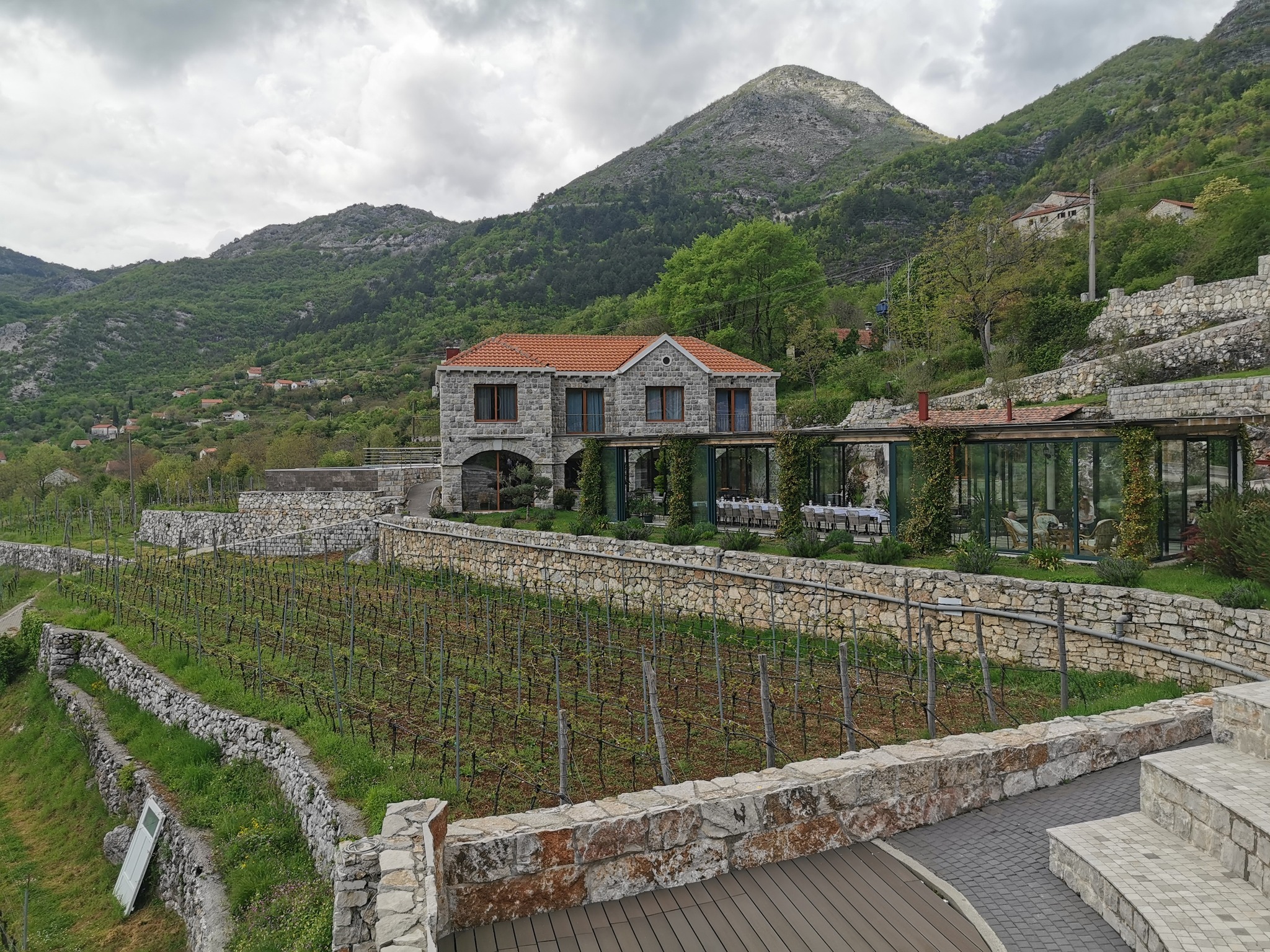

KRATOŠIJA PROBUDILA CRNOGORSKE VINARE
PROČITAJ VIŠE


VINOPEDIA TOP 10 2024
PROČITAJ VIŠE


GIUAANI - VINSKI TURIZAM NA GRUZIJSKI NAČIN
PROČITAJ VIŠE
Winner MILLESIMA BLOG AWARD 2016

Pobednik MILLESIMA BLOG AWARD 2016
VINO & FINO wine personality of the year 2016

VINO & FINO vinska ličnost godine 2016